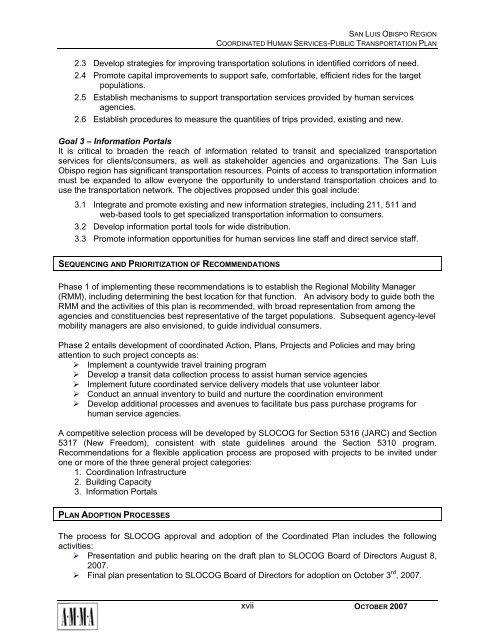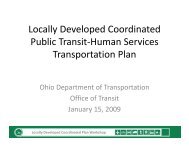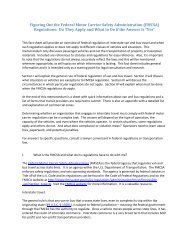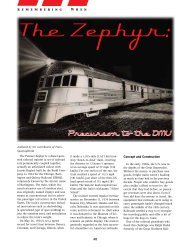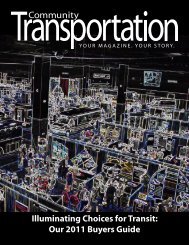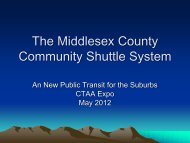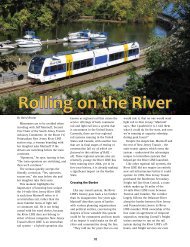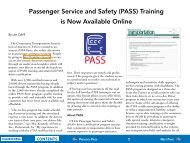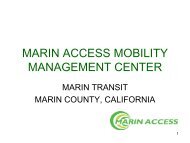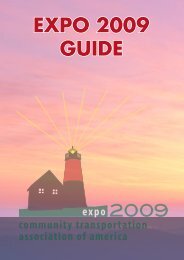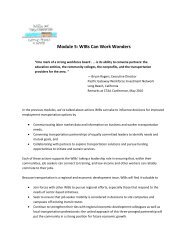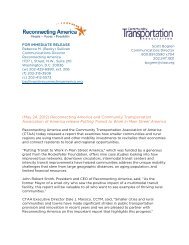San Luis Obispo - Caltrans - State of California
San Luis Obispo - Caltrans - State of California
San Luis Obispo - Caltrans - State of California
Create successful ePaper yourself
Turn your PDF publications into a flip-book with our unique Google optimized e-Paper software.
SAN LUIS OBISPO REGION<br />
COORDINATED HUMAN SERVICES-PUBLIC TRANSPORTATION PLAN<br />
2.3 Develop strategies for improving transportation solutions in identified corridors <strong>of</strong> need.<br />
2.4 Promote capital improvements to support safe, comfortable, efficient rides for the target<br />
populations.<br />
2.5 Establish mechanisms to support transportation services provided by human services<br />
agencies.<br />
2.6 Establish procedures to measure the quantities <strong>of</strong> trips provided, existing and new.<br />
Goal 3 – Information Portals<br />
It is critical to broaden the reach <strong>of</strong> information related to transit and specialized transportation<br />
services for clients/consumers, as well as stakeholder agencies and organizations. The <strong>San</strong> <strong>Luis</strong><br />
<strong>Obispo</strong> region has significant transportation resources. Points <strong>of</strong> access to transportation information<br />
must be expanded to allow everyone the opportunity to understand transportation choices and to<br />
use the transportation network. The objectives proposed under this goal include:<br />
3.1 Integrate and promote existing and new information strategies, including 211, 511 and<br />
web-based tools to get specialized transportation information to consumers.<br />
3.2 Develop information portal tools for wide distribution.<br />
3.3 Promote information opportunities for human services line staff and direct service staff.<br />
SEQUENCING AND PRIORITIZATION OF RECOMMENDATIONS<br />
Phase 1 <strong>of</strong> implementing these recommendations is to establish the Regional Mobility Manager<br />
(RMM), including determining the best location for that function. An advisory body to guide both the<br />
RMM and the activities <strong>of</strong> this plan is recommended, with broad representation from among the<br />
agencies and constituencies best representative <strong>of</strong> the target populations. Subsequent agency-level<br />
mobility managers are also envisioned, to guide individual consumers.<br />
Phase 2 entails development <strong>of</strong> coordinated Action, Plans, Projects and Policies and may bring<br />
attention to such project concepts as:<br />
‣ Implement a countywide travel training program<br />
‣ Develop a transit data collection process to assist human service agencies<br />
‣ Implement future coordinated service delivery models that use volunteer labor<br />
‣ Conduct an annual inventory to build and nurture the coordination environment<br />
‣ Develop additional processes and avenues to facilitate bus pass purchase programs for<br />
human service agencies.<br />
A competitive selection process will be developed by SLOCOG for Section 5316 (JARC) and Section<br />
5317 (New Freedom), consistent with state guidelines around the Section 5310 program.<br />
Recommendations for a flexible application process are proposed with projects to be invited under<br />
one or more <strong>of</strong> the three general project categories:<br />
1. Coordination Infrastructure<br />
2. Building Capacity<br />
3. Information Portals<br />
PLAN ADOPTION PROCESSES<br />
The process for SLOCOG approval and adoption <strong>of</strong> the Coordinated Plan includes the following<br />
activities:<br />
‣ Presentation and public hearing on the draft plan to SLOCOG Board <strong>of</strong> Directors August 8,<br />
2007.<br />
‣ Final plan presentation to SLOCOG Board <strong>of</strong> Directors for adoption on October 3 rd , 2007.<br />
xvii<br />
OCTOBER 2007


